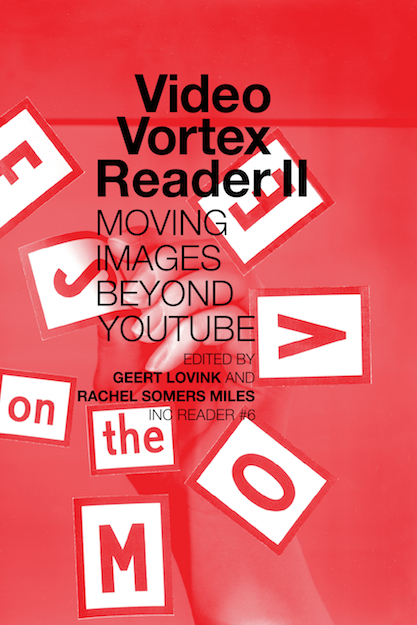Geert Lovink, Rachel Somers Miles (eds.): Video Vortex Reader II: Moving Images Beyond YouTube (2011)
Filed under book | Tags: · aesthetics, human rights, internet, media activism, network culture, online video, politics, theory, video, video art, youtube

“Video Vortex Reader II is the Institute of Network Cultures’ second collection of texts that critically explore the rapidly changing landscape of online video and its use. With the success of YouTube (’2 billion views per day’) and the rise of other online video sharing platforms, the moving image has become expansively more popular on the Web, significantly contributing to the culture and ecology of the internet and our everyday lives. In response, the Video Vortex project continues to examine critical issues that are emerging around the production and distribution of online video content.
Following the success of the mailing list, the website and first Video Vortex Reader in 2008, recent Video Vortex conferences in Ankara (October 2008), Split (May 2009) and Brussels (November 2009) have sparked a number of new insights, debates and conversations regarding the politics, aesthetics, and artistic possibilities of online video. Through contributions from scholars, artists, activists and many more, Video Vortex Reader II asks what is occurring within and beyond the bounds of Google’s YouTube? How are the possibilities of online video, from the accessibility of reusable content to the internet as a distribution channel, being distinctly shaped by the increasing diversity of users taking part in creating and sharing moving images over the web?”
Contributors: Perry Bard, Natalie Bookchin, Vito Campanelli, Andrew Clay, Alexandra Crosby, Alejandro Duque, Sandra Fauconnier, Albert Figurt, Sam Gregory, Cecilia Guida, Stefan Heidenreich, Larissa Hjorth, Mél Hogan, Nuraini Juliastuti, Sarah Késenne, Elizabeth Losh, Geert Lovink, Andrew Lowenthal, Rosa Menkman, Gabriel Menotti, Rachel Somers Miles, Andrew Gryf Paterson, Teague Schneiter, Jan Simons, Evelin Stermitz, Blake Stimson, David Teh, Ferdiansyah Thajib, Andreas Treske, Robrecht Vanderbeeken, Linda Wallace, Brian Willems, Matthew Williamson, Tara Zepel.
Publisher Institute of Network Cultures, Amsterdam, 2011
Creative Commons Attribution Noncommercial No Derivative Works 3.0 Netherlands License
ISBN 9789078146124
378 pages
PDF, PDF (updated on 2017-4-11)
Comment (0)Pelle Snickars, Patrick Vonderau (eds.): The YouTube Reader (2009)
Filed under book | Tags: · archive, internet, online video, youtube

Over the last few years YouTube has become the very epitome of digital culture. With more than 70 million unique users each month and approximately 100 million videos online, this brand-name video
distribution platform holds the richest repository of popular culture on the Internet. As the fastest growing site in the history of the Web, YouTube promises endless new opportunities for amateur video, political campaigning, entertainment formats and viral marketing – a clip culture seemingly outpacing both cinema and television. The YouTube Reader is the first full-length book to explore YouTube as an industry, an archive and a cultural form. This remarkable volume brings together renowned film and media scholars in a discussion of the potentials and pitfalls of ‘broadcasting yourself’. The YouTube Reader confronts prevalent claims to newness, immediacy or popularity with systematic and theoretically informed arguments. It offers a closer look at both texts accessible via YouTube and policies and norms governing how they are accessed and used. Among the contributors are Thomas Elsaesser, Richard Grusin, Bernard Stiegler, Toby Miller, William Uricchio and Janet Wasko.
Published by the National Library of Sweden, Stockholm, June 2009
Wallflower Press Series
National Library of Sweden Series
Volume 12 of Mediehistoriskt arkiv
ISBN: 978-9-188468-11-6
512 pages
Licensed under a Creative Commons Attribution-NonCommercial-ShareAlike 3.0 Unported License.
authors
publisher
publisher
google books
Audiovisual Thinking journal, No. 1: What is Academic Video? (2010)
Filed under journal | Tags: · audiovisual, communication, media, online video, video

Audiovisual Thinking is the world’s first journal of academic videos about audiovisuality, communication and media. The journal is a pioneering forum where academics and educators can articulate, conceptualize and disseminate their research about audiovisuality and audiovisual culture through the medium of video.
International in scope and multidisciplinary in approach, the purpose of Audiovisual Thinking is to develop and promote academic thinking in and about all aspects of audiovisuality and audiovisual culture.
Advised by a board of leading academics and thinkers in the fields of audiovisuality, communication and the media, the journal seeks to set the standard for academic audiovisual essays now and in the future.
Audiovisual Thinking. The Journal of Academic Videos
Contact: Inge Ejbye Sørensen, University of Copenhagen
Editorial board: Thommy Eriksson, Oranit Klein Shagrir, Inge Sørensen, Petri Kola, Sanna Marttila
Advisory board: Ib Bondebjerg, John Thornton Caldwell, Lily Díaz
View online (fixed on 2012-7-28)
Comment (0)
